By Trenton Chalmers
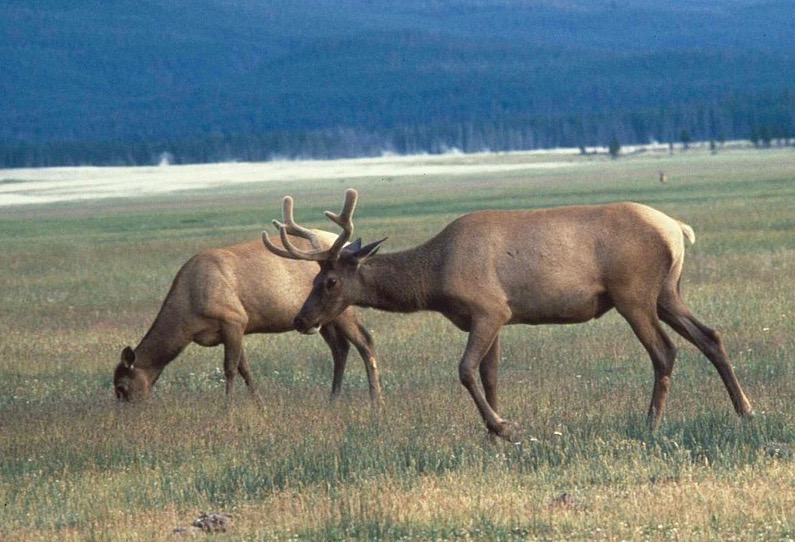
Introduction
Elk are native to North America. Pre-settlement, they flourished in the prairies of the Midwest, the historical homeland of many Native American tribes. These tribes had many uses for elk, such as meat, shelter, clothing, tools, and jewelry. Elk were also incorporated into cultural stories. For the Lakota, elk can be associated with the introduction of the flute and how the sound correlates to the bugle of a male elk. The flute was also a tool for courting. In the late 1800s, elk were extirpated from the state of North Dakota. However, in the early 1900s, following the implementation of the Theodore Roosevelt National Park, elk were reintroduced into the western part of the state (Bailey 1926). Since the 1980s, a very small, unstable elk population has been known to inhabit the Porcupine Hills within the Standing Rock Reservation. Through the years this unstable population would disappear and reappear with very few numbers. It was not until 2017 when North Dakota Game and Fish reported a semi-stable population with over 120 ungulates, based on counts from aerial views.
Elk are ungulates and fall under the same class as mules and white-tailed deer. Regardless of their similar classifications, there are noticeable differences between the elk and the deer family. In size, elk are much larger than deer but smaller than moose. Elk have a unique and distinguishable white rump which helps them camouflage into their environment. Their antlers are different from deer, as they stick straight back from the elk’s head and grow six points, whereas most deer antlers curl and only grow to about two feet and typically range from one to five points. When mature, an elk stands at four feet from the ground to its shoulder (NRCS and Wildlife Habitat Council 1999).
Before the vast expansion of European settlement, elk were free roaming in most areas of the United States, including the vast prairies of the Dakotas, and would migrate large distances to Mexico and into far northwest Canada. However, as settlers expanded into the west, the habitat and number of elk decreased. Elk are far more sensible than deer and do not domesticate, which contributed to the decline (Childress and Lung 2002). Today, managed populations of elk are most notably found in regions of high elevation and isolation (Brook 2009). After the extirpation and reintroduction of Elk into the state parks, other populations across the state began to pop up. Most notably, a small elk population was discovered within the porcupine hills, on the Standing Rock Sioux Reservation. The population was known to disappear and reappear for many seasons until recently. In 2017, aerial analysis counted over 120 individuals and determined that this small population was semi-stable and coexisted within tribal land, private land, and a designated refuge. The Porcupine Hills elk population is now co-managed by the Standing Rock Sioux Tribe and North Dakota’s Game and Fish Department, but little is known about this unique population. Therefore, the objective of my study was to determine elk presence within the Porcupine Hills. My hypothesis was that there was an increased elk presence in areas with higher vegetation density and plant diversity in the Porcupine Hills of North Dakota.
Methods
Sites
Two sites were used for this research. Both sites were located within the Porcupine Hills of North Dakota. Both locations were near one another. Site one was on tribal land and was accessed from June to July. Site two was on private land and was accessed from July to August. The sites were not chosen at random, instead they were chosen based on access.
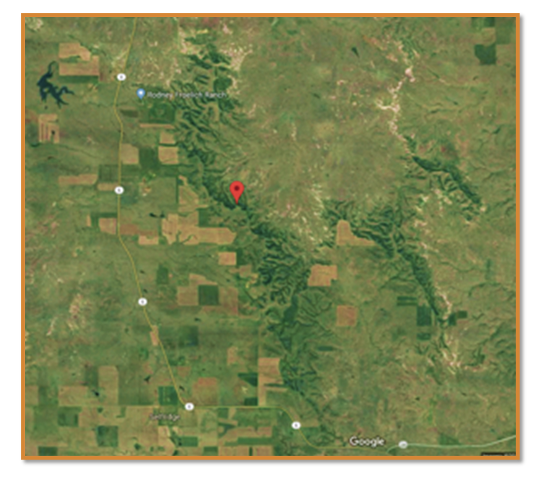
Trail Cameras
Data was recorded using photo imaging. Images were captured with trail cameras. Trail cameras were set out at each site on a 5×3 grid. There was a total of 15 cameras per site and each camera was spread out 360 meters from each other. The cameras at site one recorded data for 31 days while the cameras on site two recorded data for 15 days, due to private landowner’s permission. The sites were chosen based upon access from local landowners (Fleming and Meek 2014).
Vegetation Analysis
Visual obstruction readings were conducted to determine vegetation height using a one-meter Robel pole. Data was recorded four meters away from the camera and collected in all four cardinal directions. Observations were done by crouching down to the one-meter pole height and recording the lowest number visible. The lowest number visible was our initial recording for that direction and site.
We also recordedplant species, density, and diversity for each camera location. To gather this data, we used a one-meter square, Daubenmire square. We would measure and walk 10 meters from the camera location, for each cardinal direction, and place the square randomly on the ground. We measured the percentage of bare ground and percentage of plant species. We also identified some common plant species and recorded their percentages.
Statistical Methods
Using statistical analysis, we would discover our regression to determine if there is a correlation between elk presence and plant diversity and or plant species. All data would be examined and interpreted through software and observing images captured. These images will be analyzed and placed into categories such as behavior, sex, and age.
Results
Data was analyzed and grouped into categories that allowed for graphs and charts to be illustrated. The Porcupine Hills presented vast variety of vegetation and densities. The habitat was wooded within the steep draws and open prairie at the foot and plateau.
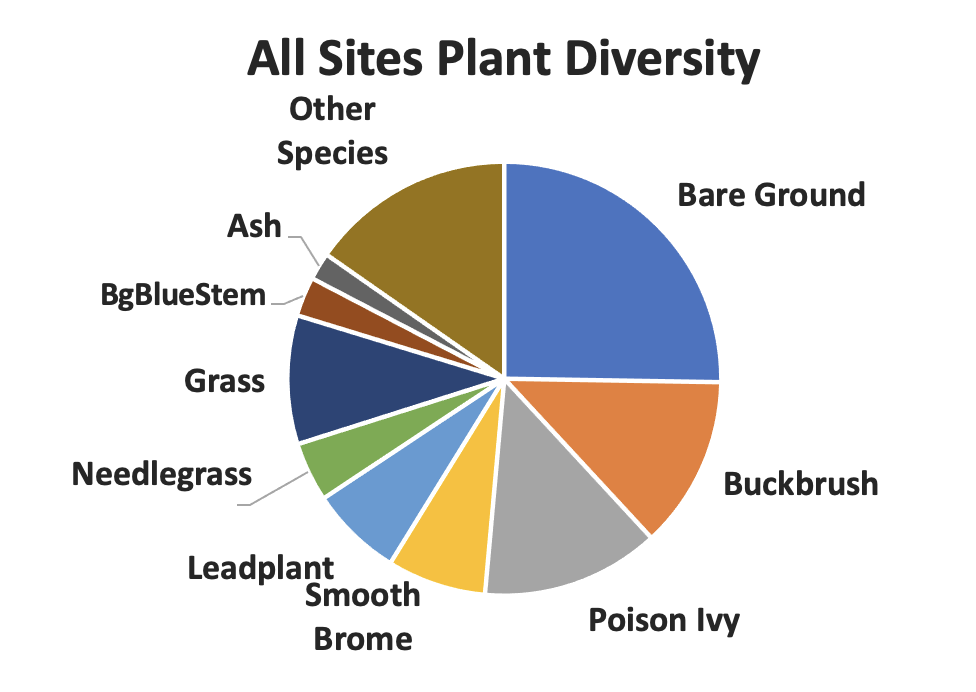
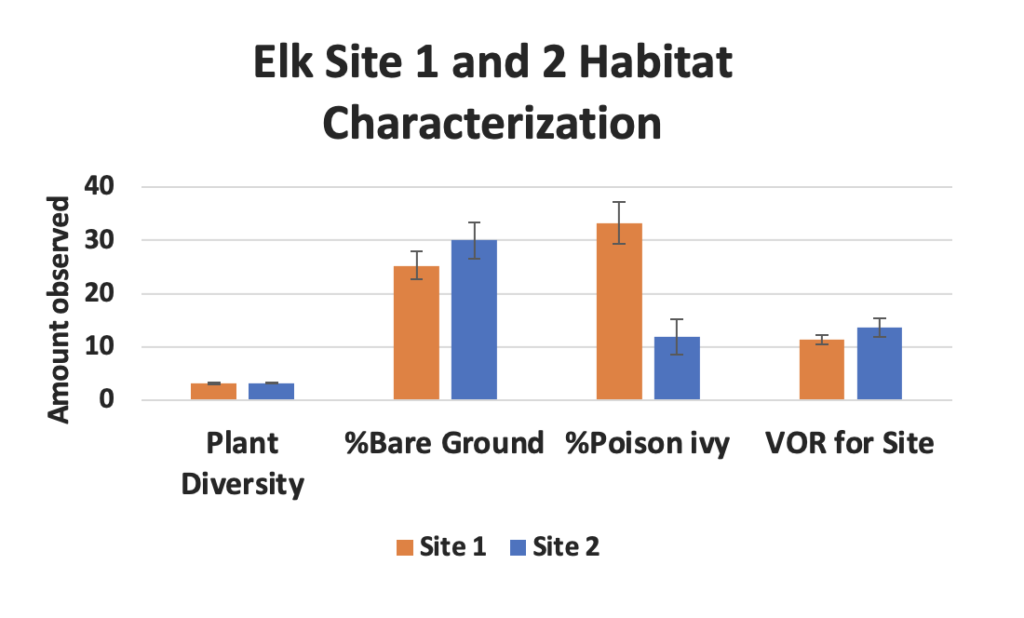
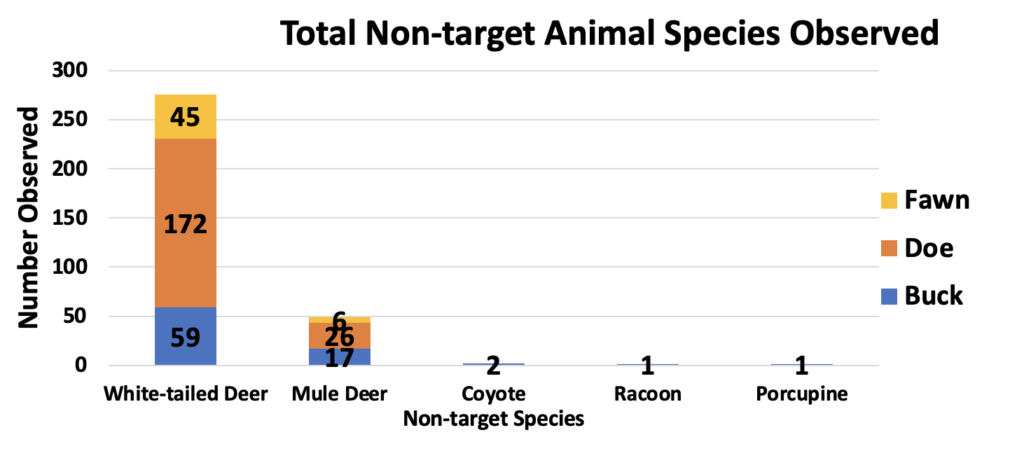
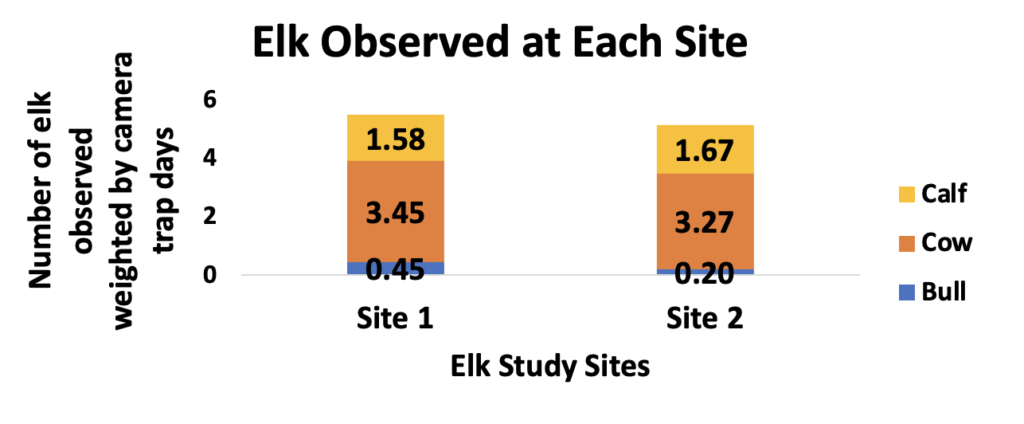
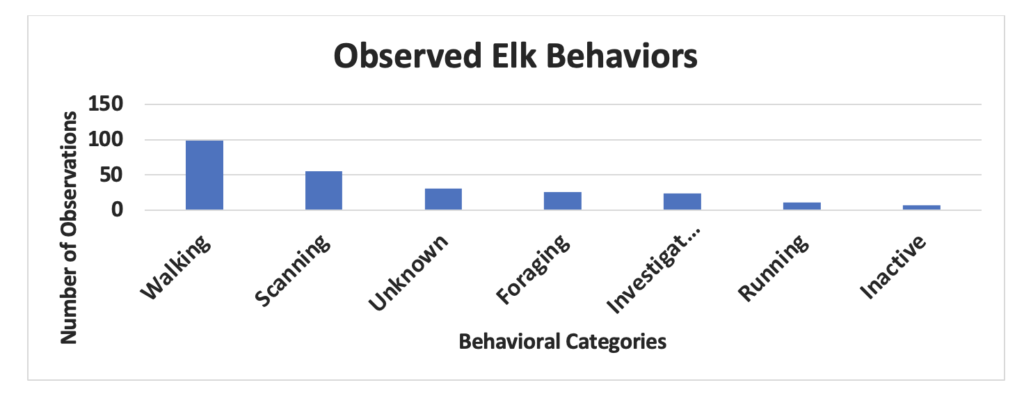
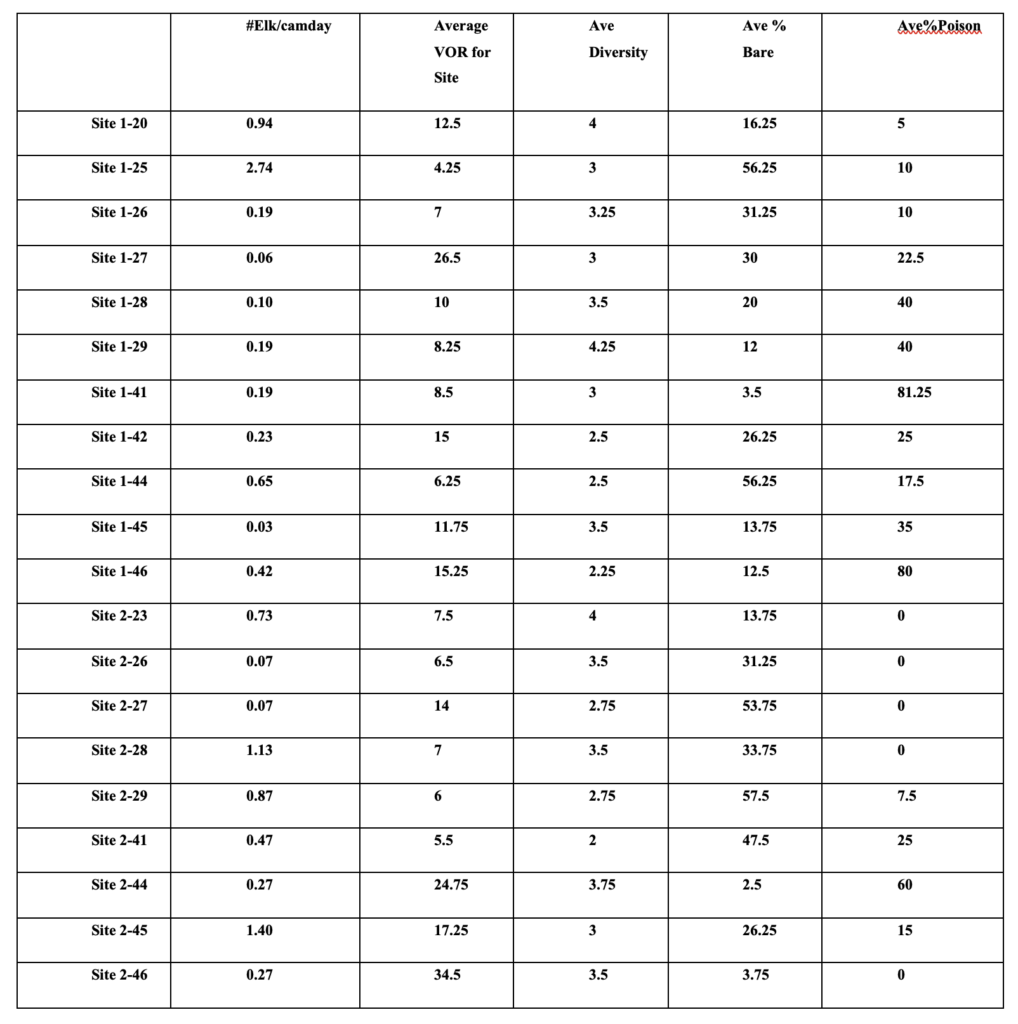
Discussion
While conducting my research within the Porcupine Hills, elk presence was evident. Our data show no relationship between elk presence and habitat characteristics. Elk were present at all study locations equally and vegetation type and density appear not to play a role in their distribution. With this knowledge, my hypothesis is rejected. Therefore, understanding the ecology of elk in the study area will assist managers in predicting dispersal into other local sites in the region and identify any unique aspects of this population. There is little to no information about the elk population that inhabits the Porcupine Hills. Additionally, understanding this population will aid in the co-management by the tribal and state game and fish departments, increase knowledge for private landowners, and preserve cultural benefits these elk bring for the tribal nation that occupies the Standing Rock Reservation. A future study could look at a larger area within the Porcupine Hills to enhance the current data set and findings. Gathering data of the population during different seasons would be greatly beneficial to this research study, agencies involved, and local landowners.
Work Cited
Bailey, V. 1926. U.S. Department of Agriculture. A Biological Survey of North Dakota. North American Fauna, No. 49.
Brook, R. 2009. Historical Review of Elk-Agriculture Conflicts in and around Riding Mountain National Park, Manitoba, Canada. Human-Wildlife Conflicts 3(1): 72-87.
Childress, M. and Lung, M. 2002. Predation Risk, Gender, and the Group Size Effect: Does Elk Vigilance Depend Upon the Behavior of Conspecifics?
Fleming, P. and Meek, P. 2014 Camera Trapping: Wildlife Management and Research: pages 3 – 12.
NRCS and Wildlife Habitat Council. 1999. American Elk (Cervus elaphus). Fish and Wildlife Habitat Management Leaflet, Number 11: 2-6.
About the Author

Hau Mitakuyapi! I am a member of the Standing Rock Sioux Tribe and in the fourth year of my undergraduate program at United Tribes Technical College where I am studying Environmental Science and Research. My passions include fisheries and wildlife, and I would love to become a contributing professional in the world of Native American fisheries and wildlife biology.
• • •
Enjoyed this Story? Enter your email to receive notifications.
